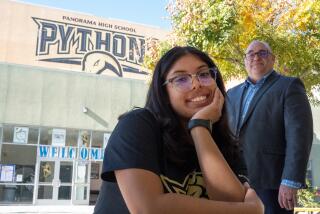Uneasy First Steps Toward Online Learning
- Share via
Someday, every high school classroom might resemble Room 304 at Villa Park High.
Students enter their morning English class, pop open their laptop computers, plug them into the portals at their desks and browse the Internet to find potential topics for research projects. They e-mail their homework to 11th-grade English teacher Connie Bohnert, who has posted her assignments and lecture notes on the class Web page. All students at the Orange County school will soon create personal Web pages to showcase their work.
As an unprecedented level of state funding for technology makes its way into high schools through the state’s Digital High School program, a few districts have wired classrooms for new classes taught exclusively for students who have laptop computers. Computer-based programs at Irvine and Mission Viejo high schools in Orange County are in their second year. The laptop learning classes at Villa Park--for 26 students who take their 11th-grade English and U.S. history classes together--are barely a month old.
Most educators, including those in the Los Angeles Unified School District, are still evaluating how best to use laptops and other technology in the classroom.
“You have an equity problem with [laptops]. We want to ensure that whatever we do with technology, we do throughout the district,” said Andy Rogers, a Los Angeles Unified administrator in information technology.
But at Redondo Beach Union High School, every incoming ninth-grader receives a laptop through the school’s Freshman Foundation program.
The laptops are used in all the freshman academic classes, including English, science and math, as well as in special education and in teaching English as a second language.
Students can also use the laptops in electives, such as French and Spanish.
“Some [projects] that used to take two to three weeks to do, they can now do them in two or three sessions. They do the research [through the Internet] instantaneously in class,” said Pat Hosken, director of the program.
One benefit of the program is that it provides the student’s entire family with computer access, so parents and siblings can get computer experience.
“I think because they were using the laptops and writing in so many classes--in math, in science, even writing e-mail--it increased their ability to respond in writing,” Hosken said.
The program, however, only sets the course for the students and does not extend to the upper grades.
Matching Classroom to the Student
At their best, such programs open vast new learning opportunities. Students become computer-savvy and can tap into virtually unlimited research opportunities while absorbing the same subject matter as their peers in traditional classes.
Yet even as districts pounce on the idea of paperless classrooms with enthusiasm and pride, the classroom of the future is not necessarily ready for the student of the present.
On a recent day at Villa Park, students were on their own for an entire class period while a teacher struggled to post the day’s assignment on the class Web page. At one point during the 55-minute class, more than a third of the students were playing computer games. The rest surfed the Internet, talked or completed work for other classes.
And, technical glitches aside, some critics say that it is unfair to have programs just for students whose families can afford a $1,200 to $2,000 laptop.
Although some parents complain that these programs create inequity, administrators say they have mechanisms in place to ensure that no child who wants to participate will be turned away; measures include PTA-sponsored scholarships and loans of school-owned computers.
For 23-year teaching veteran Ron Archer, who is team-teaching an 11th-grade laptop English and U.S. history class at Mission Viejo High School this year, the advantages of an electronic classroom are evident.
“I’m in a situation where I can see the kids’ homework that they have done before they even return to class, because they e-mail it to me. At 6 a.m. I can look at their paragraphs and say, ‘Oh, they need to work on this.’ By the time they arrive at 8 a.m., I can be ready to work on what they need,” he said.
The class Web site, https://www.AmericanJourney.net, also lets parents keep up with what their children are learning.
“We go with the idea that we’re not teaching technology. We’re teaching using technology,” Archer said.
First, the Teachers Have to Know How
Making sure that teachers are prepared to use the technology is vital, said Mission Viejo High School parent and computer entrepreneur Jack Allweiss, who heads the school’s technology committee. Allweiss was instrumental in helping Mission Viejo launch its laptop program a year ago.
“You’ve got to invest in the teachers first,” Allweiss said. “The reality is these kids have grown up with technology.”
Mission Viejo now offers four laptop classes, involving four teachers and about 120 students in 10th and 11th grades.
At Villa Park, the program’s first month was somewhat rocky, students said. Because the school learned only in August that it would be able to offer the class, teachers had little time to learn the technical ins and outs of running a class online before school opened.
“We’re a little bit behind in history,” Bill Backstrom said of his online U.S. history class at Villa Park. As a result, students said, he recently had to delay an exam for his electronic class so he could bring students up to speed with his traditional classes.
Gwen Davis, educational technology administrator for the Orange Unified School District, said she has been training the two Villa Park teachers since August.
“These people are excellent teachers, and all we’re doing is empowering them with technology,” Davis said. “They’re learning more each day.”
And several students said that despite the somewhat disappointing start, they think the classes are worthwhile.
Brett Gereau, 16, said he loves taking his classes online, adding that because his mother spent so much money on the laptop, he feels more motivated.
“I think it’s really interesting that we’re going to make our own Web pages,” he said. “That’s what I’m shooting for, learning about computers, because that’s where the future is.”
“I think it’s a wonderful opportunity,” said classmate Katie Lambert, 16, as she surfed the Web for a research project topic in Bohnert’s English class.
Lambert’s mother, Sheryl, a graphic designer whose career depends on computers, agreed that the opportunity was too good to pass up, even though it meant she had to take out a loan to finance her daughter’s laptop.
“It was a sacrifice, but I do think it’s worth it,” Sheryl Lambert said. “This is my way of getting her to type and learn how to use the computer. From the time she gets home, she’s on it almost until she goes to bed.”
*
Times staff writer Nona Yates contributed to this story.
More to Read
Sign up for Essential California
The most important California stories and recommendations in your inbox every morning.
You may occasionally receive promotional content from the Los Angeles Times.













